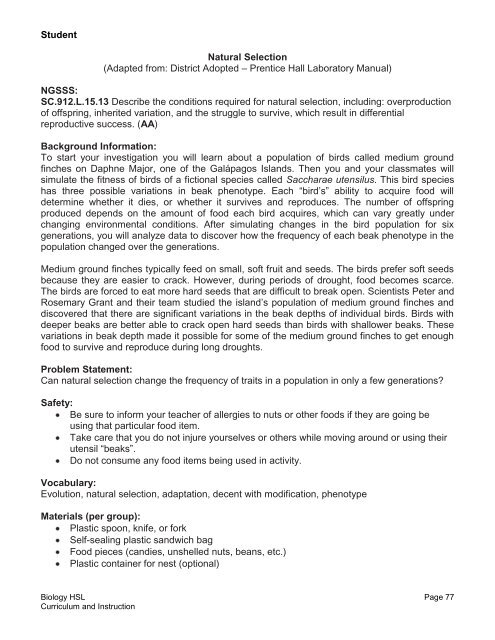Biology - HOT Science Lab
Biology - HOT Science Lab
Biology - HOT Science Lab
You also want an ePaper? Increase the reach of your titles
YUMPU automatically turns print PDFs into web optimized ePapers that Google loves.
Student<br />
Natural Selection<br />
(Adapted from: District Adopted – Prentice Hall <strong>Lab</strong>oratory Manual)<br />
NGSSS:<br />
SC.912.L.15.13 Describe the conditions required for natural selection, including: overproduction<br />
of offspring, inherited variation, and the struggle to survive, which result in differential<br />
reproductive success. (AA)<br />
Background Information:<br />
To start your investigation you will learn about a population of birds called medium ground<br />
finches on Daphne Major, one of the Galápagos Islands. Then you and your classmates will<br />
simulate the fitness of birds of a fictional species called Saccharae utensilus. This bird species<br />
has three possible variations in beak phenotype. Each ―bird‘s‖ ability to acquire food will<br />
determine whether it dies, or whether it survives and reproduces. The number of offspring<br />
produced depends on the amount of food each bird acquires, which can vary greatly under<br />
changing environmental conditions. After simulating changes in the bird population for six<br />
generations, you will analyze data to discover how the frequency of each beak phenotype in the<br />
population changed over the generations.<br />
Medium ground finches typically feed on small, soft fruit and seeds. The birds prefer soft seeds<br />
because they are easier to crack. However, during periods of drought, food becomes scarce.<br />
The birds are forced to eat more hard seeds that are difficult to break open. Scientists Peter and<br />
Rosemary Grant and their team studied the island‘s population of medium ground finches and<br />
discovered that there are significant variations in the beak depths of individual birds. Birds with<br />
deeper beaks are better able to crack open hard seeds than birds with shallower beaks. These<br />
variations in beak depth made it possible for some of the medium ground finches to get enough<br />
food to survive and reproduce during long droughts.<br />
Problem Statement:<br />
Can natural selection change the frequency of traits in a population in only a few generations<br />
Safety:<br />
Be sure to inform your teacher of allergies to nuts or other foods if they are going be<br />
using that particular food item.<br />
Take care that you do not injure yourselves or others while moving around or using their<br />
utensil ―beaks‖.<br />
Do not consume any food items being used in activity.<br />
Vocabulary:<br />
Evolution, natural selection, adaptation, decent with modification, phenotype<br />
Materials (per group):<br />
Plastic spoon, knife, or fork<br />
Self-sealing plastic sandwich bag<br />
Food pieces (candies, unshelled nuts, beans, etc.)<br />
Plastic container for nest (optional)<br />
<strong>Biology</strong> HSL Page 77<br />
Curriculum and Instruction

















